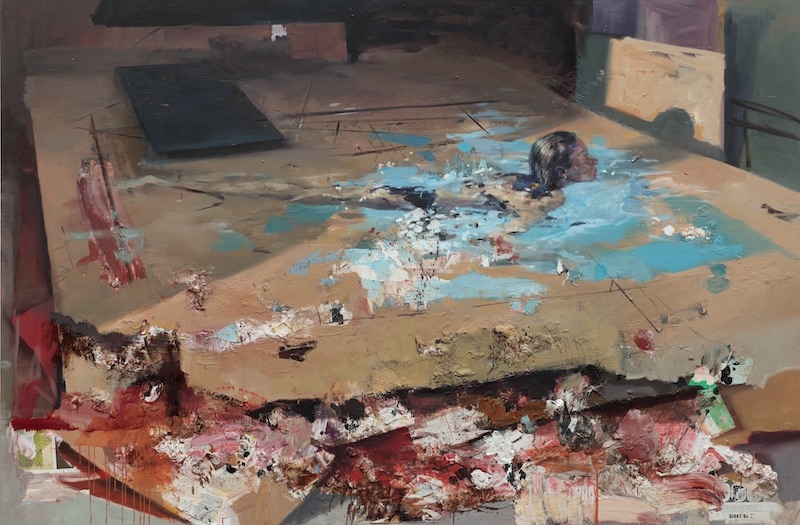A woman’s head is seen in profile, hair as sleek as an otter’s. She bobs up, as if mid-breaststroke, amid thick smears of aqua paint: this is Swimming Pool (2019), a highlight of Daniel Pitín’s substantial show of paintings and videos. The pool appears otherwise abandoned, like some relic of the good life, a signifier of societal decline. The woman’s body tips ambiguously, and indeed the scene feels only half-real: while there appears to be water directly around her, the ‘pool’ looks drained, and quite possibly not a pool but something else. She flattens into it, and the ochre concrete floor merges at the edges with junk, detritus made from scraps of collaged newspaper. The woman is Romy Schneider in Jacques Deray’s La Piscine (1969).
The Prague-born Pitín is fond of splicing two realities in one image: he melds art-historical and cinematic references in a variant on the Verfremdungseffekt, a dissection of illusion. Swimming Pool began as a maquette made from cardboard and coloured paper: the painting based on it was constructed using bits of glued newspaper and then overpainted to deliver its half-finished appearance. The artist exposes his methodology like a magician showing a trick’s mechanics. More cinematic referencing occurs in another large painting, 237 (2018). We are creepily drawn through multicoloured portals, our gaze traversing variously shaped apertures cut into a sequence of walls (reminiscent of Gordon Matta-Clark’s work), to encounter an ill-defined naked female figure holding, perhaps, a shower rail. Scratches on the canvas obscure her face, rendering her ageless; her body seems to drip with water. Suddenly there’s recognition and horror too: it’s that room 237 and that succubus thing from Stanley Kubrick’s The Shining (1980).
Lee in a Bath (2016), a sister image, catches the photographer Lee Miller blithely washing herself in Hitler’s tub as if scrubbing away evil. Pitín interrogates voyeuristic moments while suspending them: what are these lonely figures up to? In Window Blind (2017) a seated man and standing woman have their backs to us. They focus on events in front of them, things we cannot make out. As with the aforementioned paintings, such realism emerges from a hastily constructed set. Near-abstract blocks of grey and black are crisscrossed with white stripes; Pitín’s palette is muted, freighted with implicit dread. Again memory is triggered; we may remember this as a scene from Alfred Hitchcock’s Rear Window (1954): the man is James Stewart, the woman Grace Kelly.
Pitín quotes the same film in Broken Windows (2019), one of two video installations here. Scenes from the movie are projected through small apertures cut inside a tatty cardboard model of a housing block, decorated with paint smears. The scale discombobulates: the effect is like micropsia, like looking down the wrong end of a telescope. A shockingly grotesque moment arrives when Kelly’s face is seen smeared with pigment. The other video installation is weaker: Rotations (2019) features Robert De Niro as seen in Martin Scorsese’s Taxi Driver (1976), and we’ve been there too often. Pitín’s real strength lies in his paintings, and the show concludes with a bravura display. In Between Spaces (2014), another monumental canvas, shows an empty room with an enormous expanse of parquet flooring. Summer in the City (2019), even larger, presents the frontage of a building like that seen in Rear Window, now bent and ripped like another cardboard model. Balcony (2008) is perhaps the most impressive work: the reflection of a streetlamp and the shadowing of said balcony give the architectural feature a dark sense of the sinister, appropriate in this most eerie of cities.
Daniel Pitín, A Paper Tower, Galerie Rudolfinum, Prague, 26 September 2019 – 5 January 2020
From the January & February 2020 issue of ArtReview
